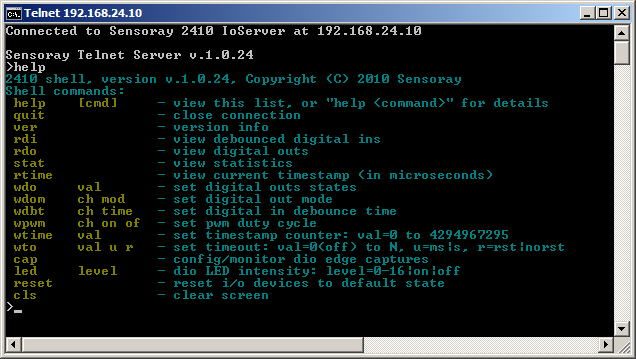Difference between revisions of "2410"
(→Relay racks: +start 48 pinout) |
(→Relay racks) |
||
| Line 45: | Line 45: | ||
The 50-pin header can be connected via flat cable to most standard solid-state (SSR) relay racks. | The 50-pin header can be connected via flat cable to most standard solid-state (SSR) relay racks. | ||
| − | + | ====7501Tx==== | |
For applications that use up to 24 SSRs it is recommended to use Sensoray model [[7501T8]], [[7501T16]] or [[7501T24]] relay racks. For more information about this, see ''[[7501Tx relay racks#Using with Sensoray 2410|Using 7501Tx relay racks with model 2410]]''. | For applications that use up to 24 SSRs it is recommended to use Sensoray model [[7501T8]], [[7501T16]] or [[7501T24]] relay racks. For more information about this, see ''[[7501Tx relay racks#Using with Sensoray 2410|Using 7501Tx relay racks with model 2410]]''. | ||
| − | + | ====Others==== | |
Various third-party relay racks are available for applications that use more than 24 SSRs. For example, SSR-RACK48 supports up to 48 SSRs. To use this rack with model 2410, you must provide an external 5 VDC power supply (see [[7501Tx relay racks#Rack power|this]] for details). These are the pin functions when a 2410 module is connected to a SSR-RACK48: | Various third-party relay racks are available for applications that use more than 24 SSRs. For example, SSR-RACK48 supports up to 48 SSRs. To use this rack with model 2410, you must provide an external 5 VDC power supply (see [[7501Tx relay racks#Rack power|this]] for details). These are the pin functions when a 2410 module is connected to a SSR-RACK48: | ||
Revision as of 08:02, 16 July 2018
Model 2410 is a compact open-frame module that interfaces 48 general-purpose TTL/CMOS digital input/output (DIO) signals to Ethernet. It features edge detection, PWM output mode and other functions that offload work from the host computer in measurement and control applications.
Contents |
Telnet
Timeouts
I disabled the 2410 communication watchdog timer but the connection still times out after 5 minutes. Why is this happening?
The 2410's communication watchdog is disabled by sending a wto 0 command. However, most telnet clients also have their own inactivity timer, which is set to a default interval (typically 5 minutes). Consequently, the telnet client will independently close the connection when the session is idle for longer than its own timer interval. To resolve this, you must reconfigure your telnet client to use a different interval.
Remote echo
The 2410 seems to be retransmitting every TCP packet. Why is this happening?
By default, the 2410 echoes all incoming data. To turn off the remote echo function, have your telnet client issue an IAC DONT ECHO command to the 2410.
Command line functions
Where can I find information about the 2410's telnet commands?
For detailed information about telnet commands, please see Sensoray Model 2410 Command Line Protocol.
If you are manually controlling a 2410 via telnet and you just need a quick list of available commands, type 'help' at the shell prompt and hit return. When you do this you will see something like the following:
For more specific information about a particular command, type 'help <command>' and hit enter. For example, for information about the wdo (write digital outputs) command, type 'help wdo'.
How to connect loads
All DIO signals are conveyed through 7410 header J2. A DIO signal is active-low and therefore should be connected to the negative input of its load. For example, when interfacing to a solid-state relay (SSR), connect the DIO signal to the SSR's "-" logic pin.
Loads also require a connection to +5 V (e.g., the "+" logic pin of an SSR). It is recommended to supply this from an external 5 VDC power supply which shares a common ground with the 2410 module (available at J2 pin 50). Alternatively, if only a small amount of load current is needed, you can obtain +5 V directly from the 2410 module, at J4 pin 1 or J5 pins 1-8.
Using a 2410TA
Model 2410TA is a compact breakout board that plugs directly onto a 2410 module. It has two spring-activated terminals per DIO which accept 16- to 24-gauge wires. For each DIO, the silkscreen legend indicates the DIO number and its "+" and "-" terminals. The "+" terminal conveys +5 VDC and the "-" terminal conveys the active-low DIO signal.
To connect a model 2410TA to a load:
- Route the "+" terminal to the load's positive input and route the "-" terminal to the load's negative input.
- The load's positive and negative inputs should only connect to the 2410TA "+" and "-" terminals; they must not connect to any other circuit nets in your system.
- The load must not draw more than 24 mA (load input resistance must be > 208 Ω).
Relay racks
The 50-pin header can be connected via flat cable to most standard solid-state (SSR) relay racks.
7501Tx
For applications that use up to 24 SSRs it is recommended to use Sensoray model 7501T8, 7501T16 or 7501T24 relay racks. For more information about this, see Using 7501Tx relay racks with model 2410.
Others
Various third-party relay racks are available for applications that use more than 24 SSRs. For example, SSR-RACK48 supports up to 48 SSRs. To use this rack with model 2410, you must provide an external 5 VDC power supply (see this for details). These are the pin functions when a 2410 module is connected to a SSR-RACK48:
| Header Pin |
SSR Socket |
2410 GPIO |
|---|---|---|
| 1 | 32 | 31 |
| 2 | 31 | 30 |
| 3 | 30 | 29 |
| 4 | 29 | 28 |
| 5 | 28 | 27 |
| 6 | 27 | 26 |
| 7 | 26 | 25 |
| 8 | 25 | 24 |
| 9 | 40 | 39 |


